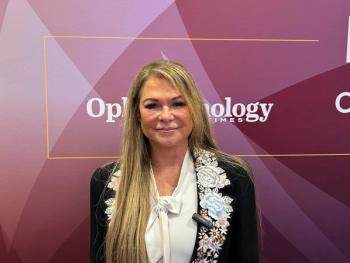
Visus Therapeutics CEO announces acquisition of ViewPoint Therapeutics to expand on cataract, presbyopia candidate
Ben Bergo, CEO of Visus Therapeutics, announced the acquisition of all patents and other assets of ViewPoint Therapeutics, which will accelerate development of novel alpha-crystallin chaperone compounds as a non-surgical treatment for age-related cataracts.
Video transcript
David Hutton: I'm David Hutton of Ophthalmology Times. I'm joined today by Ben Bergo, CEO of Visus Therapeutics, who will be presenting at Eyecelerator at the American Academy of Ophthalmology 2022 annual meeting in Chicago. Thanks for joining us today. Tell us about your presentation and what's new at Visus.
Ben Bergo: Thank you, David. And thank you for the opportunity to provide this briefing on what I presented at Eyecelerator. As many of you will be aware, Visus Therapeutics is a clinical stage company. With a lead program in presbyopia and a rapidly expanding pipeline of novel multi-target ophthalmic drug candidates.
We announced at Eyecelerator that we acquired a new set of drug candidates actually for managing both presbyopia and cataract, but also provided just some further data and insights into what we're doing with our miotic eye drops under development. So at the moment, again in in phase , we 3 have two miotic eye drops in development.
We have brimochol PF, which is a preservative free combination drug to create a pinhole effect, and provide an improvement in near vision for patients globally. This is a combination of carbachol and brimonidine.
And we saw from our VIVID phase 2 study results along with durable improvement in near vision with this, with this drug candidate. And we also saw from those phase 2 results, a benefit of the combination over the monotherapy. So we saw that with the additional brimonidine. The combination dominated the monotherapy alone the carbachol alone.
I also presented the patient reported outcomes from this study. So importantly, at the end of each dosing day, we would ask subjects in the study: What did you think of the eyedrops? And they gave very, very good feedback on brimochol, and carbachol also. They said that they would see and want to use brimochol potentially, you know, 8 days out of 10. And that's after a full day in the clinic, you know 10 hours in the clinic. And that was, that was statistically significant.
So I provided some updates on again, that lead program. We are in the middle of those 2 phase 3s, BRIO-I and BRIO-II. BRIO-I, we'll be reading out its top line [results] in the first quarter of next year. It's 170 subjects in that study. And then the second study, BRIO-II, will move through to its read outs in the first half of next year too, and then we move forward to filing in the in the second half of next year.
So that's our miotic strategy that's creating again a pinhole to provide an improvement in near vision for people. The alternative approach obviously for many presbyopia, but also cataract, is to actually go after obviously the naturally occurring changes in the lens.
So again, as we age, our lens starts to harden, and we form, we form aggregates. And this hardening obviously prevents accomodation. We can't change the shape of that lens, because again, it's becoming harder with age. That first presents as presbyopia, but then secondly can move forward as those aggregates increase and we get opacity can, can move forward to cataract. And obviously, cataract is a major form of visual impairment globally.
So again, we've acquired acid compounds, to allow us to develop a disease-modifying drug. So a drug that would actually start to undo this protein misfolding in the lens and potentially slow down the progression of presbyopia an/or potentially reverse cataract in patients.
So we're incredibly excited by that development. This is giving us obviously two approaches to managing presbyopia and cataract and and I presented on that at Eyecelerator.
Hutton: Excellent. Ultimately, what can these new therapeutics mean for patients?
Bergo: So what it means for patients is, is choice, obviously, and what it means for them is potentially again, a disease-modifying drug. So as we're aware of these miotics are treating, obviously, the underlying change in lens function, and they're doing that by again, creating a pinhole effect. This other therapeutic candidate that we have under development would go after, again the lens itself and would be able to restore vision in that way.
Hutton: So a lot of great news. Thank you for sharing it with us. Thank you very much appreciate you having me.
Newsletter
Don’t miss out—get Ophthalmology Times updates on the latest clinical advancements and expert interviews, straight to your inbox.








































